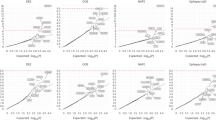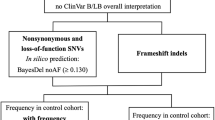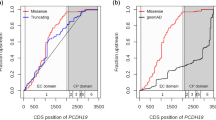Abstract
Epileptic encephalopathies are a devastating group of epilepsies with poor prognosis, of which the majority are of unknown etiology. We perform targeted massively parallel resequencing of 19 known and 46 candidate genes for epileptic encephalopathy in 500 affected individuals (cases) to identify new genes involved and to investigate the phenotypic spectrum associated with mutations in known genes. Overall, we identified pathogenic mutations in 10% of our cohort. Six of the 46 candidate genes had 1 or more pathogenic variants, collectively accounting for 3% of our cohort. We show that de novo CHD2 and SYNGAP1 mutations are new causes of epileptic encephalopathies, accounting for 1.2% and 1% of cases, respectively. We also expand the phenotypic spectra explained by SCN1A, SCN2A and SCN8A mutations. To our knowledge, this is the largest cohort of cases with epileptic encephalopathies to undergo targeted resequencing. Implementation of this rapid and efficient method will change diagnosis and understanding of the molecular etiologies of these disorders.
This is a preview of subscription content, access via your institution
Access options
Subscribe to this journal
Receive 12 print issues and online access
$209.00 per year
only $17.42 per issue
Buy this article
- Purchase on SpringerLink
- Instant access to full article PDF
Prices may be subject to local taxes which are calculated during checkout


Similar content being viewed by others
Accession codes
Accessions
NCBI Reference Sequence
References
Berg, A.T. et al. Revised terminology and concepts for organization of seizures and epilepsies: report of the ILAE Commission on Classification and Terminology, 2005–2009. Epilepsia 51, 676–685 (2010).
Kamien, B.A., Cardamone, M., Lawson, J.A. & Sachdev, R. A genetic diagnostic approach to infantile epileptic encephalopathies. J. Clin. Neurosci. 19, 934–941 (2012).
Mefford, H.C. et al. Rare copy number variants are an important cause of epileptic encephalopathies. Ann. Neurol. 70, 974–985 (2011).
Heinzen, E.L. et al. Rare deletions at 16p13.11 predispose to a diverse spectrum of sporadic epilepsy syndromes. Am. J. Hum. Genet. 86, 707–718 (2010).
Capelli, L.P. et al. Deletion of the RMGA and CHD2 genes in a child with epilepsy and mental deficiency. Eur. J. Med. Genet. 55, 132–134 (2012).
Dhamija, R. et al. Microdeletion of chromosome 15q26.1 in a child with intractable generalized epilepsy. Pediatr. Neurol. 45, 60–62 (2011).
Marfella, C.G. & Imbalzano, A.N. The Chd family of chromatin remodelers. Mutat. Res. 618, 30–40 (2007).
Bouazoune, K. & Kingston, R.E. Chromatin remodeling by the CHD7 protein is impaired by mutations that cause human developmental disorders. Proc. Natl. Acad. Sci. USA 109, 19238–19243 (2012).
Rauch, A. et al. Range of genetic mutations associated with severe non-syndromic sporadic intellectual disability: an exome sequencing study. Lancet 380, 1674–1682 (2012).
Neale, B.M. et al. Patterns and rates of exonic de novo mutations in autism spectrum disorders. Nature 485, 242–245 (2012).
O'Roak, B.J. et al. Multiplex targeted sequencing identifies recurrently mutated genes in autism spectrum disorders. Science 338, 1619–1622 (2012).
Hamdan, F.F. et al. Mutations in SYNGAP1 in autosomal nonsyndromic mental retardation. N. Engl. J. Med. 360, 599–605 (2009).
Hamdan, F.F., Gauthier, J., Rouleau, G.A. & Michaud, J.L. De novo mutations in SYNGAP1 associated with non-syndromic mental retardation. Med. Sci. (Paris) 26, 133–135 (2010).
Hamdan, F.F. et al. De novo SYNGAP1 mutations in nonsyndromic intellectual disability and autism. Biol. Psychiatry 69, 898–901 (2011).
Hamdan, F.F. et al. Excess of de novo deleterious mutations in genes associated with glutamatergic systems in nonsyndromic intellectual disability. Am. J. Hum. Genet. 88, 306–316 (2011).
Berryer, M.H. et al. Mutations in SYNGAP1 cause intellectual disability, autism and a specific form of epilepsy by inducing haploinsufficiency. Hum. Mutat. 34, 385–394 (2013).
Vissers, L.E. et al. A de novo paradigm for mental retardation. Nat. Genet. 42, 1109–1112 (2010).
de Ligt, J. et al. Diagnostic exome sequencing in persons with severe intellectual disability. N. Engl. J. Med. 367, 1921–1929 (2012).
Thierry, G. et al. Molecular characterization of 1q44 microdeletion in 11 patients reveals three candidate genes for intellectual disability and seizures. Am. J. Med. Genet. A. 158A, 1633–1640 (2012).
Need, A.C. et al. Clinical application of exome sequencing in undiagnosed genetic conditions. J. Med. Genet. 49, 353–361 (2012).
Shen, J. et al. Mutations in PNKP cause microcephaly, seizures and defects in DNA repair. Nat. Genet. 42, 245–249 (2010).
Tsai, M.H. et al. Clinical genetic study of the epilepsy-aphasia spectrum. Epilepsia 54, 280–287 (2013).
Escayg, A. et al. Mutations of SCN1A, encoding a neuronal sodium channel, in two families with GEFS+2. Nat. Genet. 24, 343–345 (2000).
Oliva, M., Berkovic, S.F. & Petrou, S. Sodium channels and the neurobiology of epilepsy. Epilepsia 53, 1849–1859 (2012).
Ogiwara, I. et al. De novo mutations of voltage-gated sodium channel αII gene SCN2A in intractable epilepsies. Neurology 73, 1046–1053 (2009).
Kamiya, K. et al. A nonsense mutation of the sodium channel gene SCN2A in a patient with intractable epilepsy and mental decline. J. Neurosci. 24, 2690–2698 (2004).
Veeramah, K.R. et al. De novo pathogenic SCN8A mutation identified by whole-genome sequencing of a family quartet affected by infantile epileptic encephalopathy and SUDEP. Am. J. Hum. Genet. 90, 502–510 (2012).
Weckhuysen, S. et al. KCNQ2 encephalopathy: emerging phenotype of a neonatal epileptic encephalopathy. Ann. Neurol. 71, 15–25 (2012).
Fujiwara, T. et al. Mutations of sodium channel α subunit type 1 (SCN1A) in intractable childhood epilepsies with frequent generalized tonic-clonic seizures. Brain 126, 531–546 (2003).
Camprubí, C. et al. Novel UBE3A mutations causing Angelman syndrome: different parental origin for single nucleotide changes and multiple nucleotide deletions or insertions. Am. J. Med. Genet. A. 149A, 343–348 (2009).
Mills, P.B. et al. Neonatal epileptic encephalopathy caused by mutations in the PNPO gene encoding pyridox(am)ine 5′-phosphate oxidase. Hum. Mol. Genet. 14, 1077–1086 (2005).
Heron, S.E. et al. Missense mutations in the sodium-gated potassium channel gene KCNT1 cause severe autosomal dominant nocturnal frontal lobe epilepsy. Nat. Genet. 44, 1188–1190 (2012).
Marco, E.J. et al. ARHGEF9 disruption in a female patient is associated with X linked mental retardation and sensory hyperarousal. BMJ Case Rep. 2009, bcr06.2009.1999 (2009) Epub 2009 Jul 2.
Mastrangelo, M. & Leuzzi, V. Genes of early-onset epileptic encephalopathies: from genotype to phenotype. Pediatr. Neurol. 46, 24–31 (2012).
Tao, H. et al. Mutations in prickle orthologs cause seizures in flies, mice, and humans. Am. J. Hum. Genet. 88, 138–149 (2011).
Endele, S. et al. Mutations in GRIN2A and GRIN2B encoding regulatory subunits of NMDA receptors cause variable neurodevelopmental phenotypes. Nat. Genet. 42, 1021–1026 (2010).
Hoppman-Chaney, N., Wain, K., Seger, P., Superneau, D. & Hodge, J. Identification of single gene deletions at 15q13.3: further evidence that CHRNA7 causes the 15q13.3 microdeletion syndrome phenotype. Clin. Genet. 83, 345–351 (2013).
Talkowski, M.E. et al. Assessment of 2q23.1 microdeletion syndrome implicates MBD5 as a single causal locus of intellectual disability, epilepsy, and autism spectrum disorder. Am. J. Hum. Genet. 89, 551–563 (2011).
Zweier, M. et al. Mutations in MEF2C from the 5q14.3q15 microdeletion syndrome region are a frequent cause of severe mental retardation and diminish MECP2 and CDKL5 expression. Hum. Mutat. 31, 722–733 (2010).
Mefford, H.C. et al. Genome-wide copy number variation in epilepsy: novel susceptibility loci in idiopathic generalized and focal epilepsies. PLoS Genet. 6, e1000962 (2010).
Acknowledgements
We thank the individuals with epileptic encephalopathies and their families for participating in our research. H.C.M. is supported by a grant from the US National Institutes of Health (NIH; National Institute of Neurological Disorders and Stroke (NINDS) 1R01NS069605) and is a recipient of a Burroughs Wellcome Fund Career Award for Medical Scientists. This work was supported by the National Health and Medical Research Council of Australia (program grant 628952 to S.F.B. and I.E.S., practitioner fellowship 1006110 to I.E.S.) and a Health Research Council of New Zealand project grant to L.G.S.
Author information
Authors and Affiliations
Contributions
G.L.C., H.C.M. and I.E.S. designed the study and wrote the manuscript. H.C.M. and I.E.S. supervised the study. G.L.C. constructed libraries, developed the variant calling pipeline (with assistance from J.C.) and analyzed the sequence data. B.J.O. and J.S. developed the molecular inversion probe (MIP) methodology and analysis pipeline. S.B.H., S.C.Y., J.M.M., S.C., S.M., G.W., T.S., A.M.E.B., A.B., K.B.H., S.K., M.T.M., V.R.-C., R.W., A. Korczyn, Z.A., N.Z., T.L.-S., D.L., R.S.M., D.G., D.M.A., J.L.F., L.G.S., S.F.B. and I.E.S. performed phenotypic analysis. S.B.H., J.M.M., S.F.B. and I.E.S. critically reviewed the manuscript. G.L.C. and A. Khan performed segregation analysis experiments. M.O.D. and M.W. performed Illumina HiSeq sequencing.
Corresponding authors
Ethics declarations
Competing interests
The authors declare no competing financial interests.
Supplementary information
Supplementary Text and Figures
Supplementary Figures 1–5, Supplementary Tables 1–3, Supplementary Note (PDF 2037 kb)
Rights and permissions
About this article
Cite this article
Carvill, G., Heavin, S., Yendle, S. et al. Targeted resequencing in epileptic encephalopathies identifies de novo mutations in CHD2 and SYNGAP1. Nat Genet 45, 825–830 (2013). https://doi.org/10.1038/ng.2646
Received:
Accepted:
Published:
Issue Date:
DOI: https://doi.org/10.1038/ng.2646



